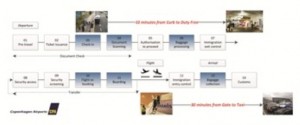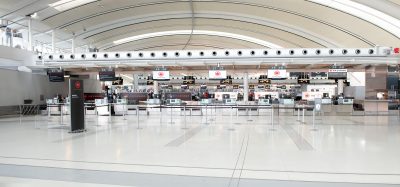Passenger Flow: A holistic approach to fast travel
- Like
- Digg
- Del
- Tumblr
- VKontakte
- Buffer
- Love This
- Odnoklassniki
- Meneame
- Blogger
- Amazon
- Yahoo Mail
- Gmail
- AOL
- Newsvine
- HackerNews
- Evernote
- MySpace
- Mail.ru
- Viadeo
- Line
- Comments
- Yummly
- SMS
- Viber
- Telegram
- Subscribe
- Skype
- Facebook Messenger
- Kakao
- LiveJournal
- Yammer
- Edgar
- Fintel
- Mix
- Instapaper
- Copy Link
Posted: 9 October 2013 | Marie-Louise Lotz, Director of Passenger Services at Copenhagen Airports A/S | No comments yet
Marie-Louise Lotz, Director of Passenger Services at Copenhagen Airports A/S, details the airport’s World Class Hub strategy which uses self-service and e-initiatives to achieve seamless travel through the airport.
Marie-Louise Lotz, Director of Passenger Services at Copenhagen Airports A/S, details the airport’s World Class Hub strategy which uses self-service and e-initiatives to achieve seamless travel through the airport.
Inspired by IATA’s ‘Simplifying the Business’ program and the Association’s Fast Travel Working Group’s focus on the 14 step end-to-end passenger process, Copenhagen Airport (CPH) has adopted a holistic view of the whole passenger process; offering passengers a wide range of self-service solutions to ease their way through the airport.
Copenhagen Airport is one of the primary gateways to Northern Europe and with 23.3 million passengers passing through in 2012, it is also the largest airport in the region. To secure its position as the main hub of northern Europe and Denmark’s gateway to growth, the airport initiated a new strategy two years ago called ‘World Class Hub’.
Under the strategy Copenhagen Airport is putting the customers – that’s passengers, airlines, concessionaires and cargo operators – first, because good conditions for airlines and satisfied passengers will lead to increased routes and thus economic growth in the whole Copenhagen-Malmö region.
Learning about your customers should be a priority, and to this end Copenhagen Airport recently conducted over 70 interviews with representatives from more than 20 airlines to learn about their wishes and needs. Furthermore the airport interviews approximately 130,000 passengers each year to get closer to its customers. The information gathered is then used to offer airlines and passengers the best possible conditions and services.
A common theme which came out of the most recent interviews was the wish for more self-service solutions. A seamless experience not only decreases congestion in the airport, but it allows travellers to exercise more control and therefore have a less stressful experience.
Copenhagen Airport and the Scandinavian flag carrier airline SAS were first movers on selfservice kiosks. SAS was the first airline to bring its own kiosks to the airport and today it has 39 kiosks at Copenhagen Airport. In addition, Copenhagen Airport has 99 common use selfservice (CUSS) kiosks with 44 airlines offering self-service check-in. This is more than two thirds of the airlines operating out of Copenhagen, which is more than any other airport in the world.
Furthermore Copenhagen Airport has installed self-service kiosks at off-airport sites including several Danish domestic airports, the nearby Hilton Hotel, Copenhagen Central Station and even on the Faroe Islands. The result? During July 2013 almost 40 per cent of the airport’s passengers used the kiosks to check-in – a growth of nearly 10 per cent in just two years. If you add the percentage of travellers checking-in either via a mobile device or on the internet, almost three out of four passengers at Copenhagen Airport use some form of self-service check-in.
This level of self-service is not achieved over night. Copenhagen Airport installed its first CUSS kiosks almost 10 years ago and in recent years the airport has used the knowledge gained from developing the kiosks and ‘educating’ the passengers to implement other self-service solutions.
Copenhagen Airport introduced its first self-service initiatives years before IATA launched its Fast Travel Program in 2007. But the Program has still become a guideline and inspiration to the airport in developing further self-service enterprises and recently also e-solution initiatives, to create a seamless journey through the airport.
According to IATA, industry trends show that passengers are driving the increased use of self-service not only at check-in, but throughout the journey. Passengers now expect to exercise control over more of the journey as they see real added value from self-service options – namely speed, convenience and control. In the end the seamless travel solutions should drive down costs and increase passenger satisfaction to the benefit of airlines, passengers and airport.
IATA’s 14 step end-to-end passenger process (see Figure 1) supports the overall vision of a seamless travel experience. The goal of the process is to ensure that at departure a passenger can get from kerb side to taxi-free within 10 minutes; and that at arrival passengers can get from the gate to the taxi within 30 minutes.
In order to reach these goals not only more self-service solutions were needed but a totally different approach to the travel chain was to be implemented. Copenhagen Airport realised the necessity of not constraining itself when looking at future solutions; that a holistic view of the whole travel chain should be taken.
IATA’s Fast Travel Working Group is developing standards and recommended practices to enhance the passenger movement by concentrating on six of the 14 steps (highlighted in Figure 1 in blue), namely check-in; document scanning; baggage processing; flight re-booking; boarding; and baggage collection. Copenhagen Airport is keen to ensure that these initiatives are available to all its airline customers.
Today CPH is proud to announce that in collaboration with 54 of its resident airlines, it can offer at least one of the above initiatives to its passengers. This is a great achievement in itself, but what is more impressive is that native network carrier SAS was the first airline in the world to implement all six initiatives, at Copenhagen Airport.
Implementation has continued at the airport and Copenhagen Airports A/S is working on implementing the next generation of solutions, including:
● Self-service bag drop
● Self-service kiosks for re-booking
● Self-service e-gates before the security check point at the gates
● Improved intelligent way finding
● Automated border control.
Each and every solution will give passengers the required increased control over their journey and will decrease operational costs for both the airport and the airlines.
Lowering customers’ operational costs is a vital part of Copenhagen Airport’s World Class Hub strategy. Reducing the operational costs is a growth enabler and CPH has experienced success with implementing common use check-in for airlines, for example, within the same alliance, which reduces handling costs.
Another example of the airport’s focus on the customer’s total cost of operation (this time not related to the passenger process in the terminal) is the ‘efficiency stands’ that Copenhagen Airport offers to its airlines. The efficiency stands help streamline the turnaround processes thereby reducing the airlines’ turnaround time.
A report commissioned by EUROCONTROL a couple of years ago documents the cost of a ground delay, with network effect, to be €78 per minute. In comparison, according to recent IATA figures an airline’s average revenue per passenger is around €3. These figures clearly demonstrate that working on efficiency processes and smart solutions throughout the airport is in the airlines’ interest. Every step towards a more efficient process benefits the passengers; giving them a more enjoyable and smoother travel experience. And what benefits airlines and passengers will be in the interest of the airport!
But not all airport solutions have to be physical. Through investing in a mobile app with augmented reality and 360-degree wayfinding photos with free Wi-Fi, Google indoor maps and Bluetooth that measures the passenger flow at the airport, Copenhagen Airport passengers are offered bespoke real-time information about their journey.
The Copenhagen Airport app has proven very successful, with approximately 500,000 downloads. It is available in four different languages (Chinese will be added in late-2013) for all major smartphones. One of the app’s functionalities is translating signs and other commercial points of interest. Way-finding maps in Chinese will also be included.
Furthermore the airport is using advanced location analytics to track the passenger flow of those passing through the international terminal. As a result, the airport can determine the appropriate level of security personnel and staff that is needed to support the passengers in a timely manner. The analytics captured over the network also allow Copenhagen Airport to monitor passenger movements from incoming flights; enabling airport staff to act accordingly in the clearance and customs department.
For the future, Copenhagen Airport is looking to also implement push notifications with flight information and other relevant material pertinent to a passenger, as well as ensuring an appropriate level of staffing is present to assist the travellers when needed.
A positive passenger experience is invaluable to any airport. Self-service and e-solutions benefit passengers, airlines and the airport itself. Apart from allowing the passenger increased control over their journeys, almost all self-service solutions reduce costs and thereby enable future growth.
Using industry standards as the minimum, Copenhagen Airport is creating a traveller environment whereby passenger convenience is paramount and is enhanced by technology and process management.
Biography
Marie-Louise Lotz is Director of Passenger Relations at Copenhagen Airports A/S. She is responsible for passenger processes and facilities throughout the terminals, including: check-in; transfer passenger process; signage and directions including manned information desk; forecourt optimisation; landside infrastructure; the call centre and car parking. Before joining Copenhagen, Marie-Louise had over 20 years of hotel management experience, including as a Hotel Director.

















